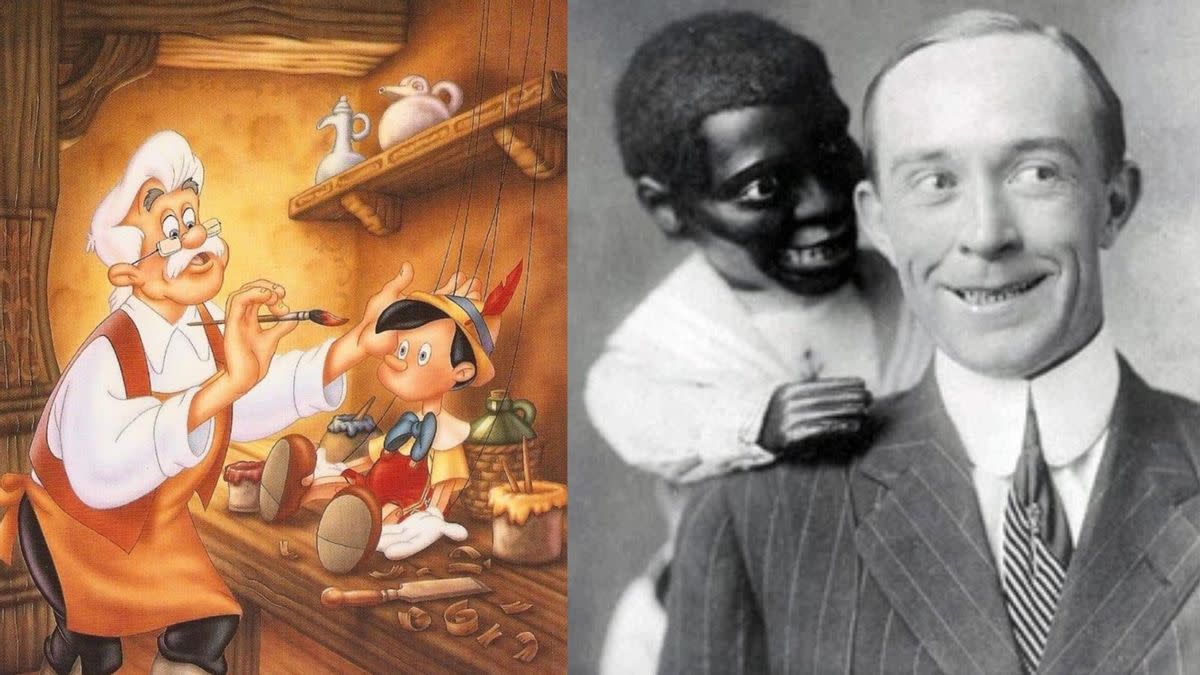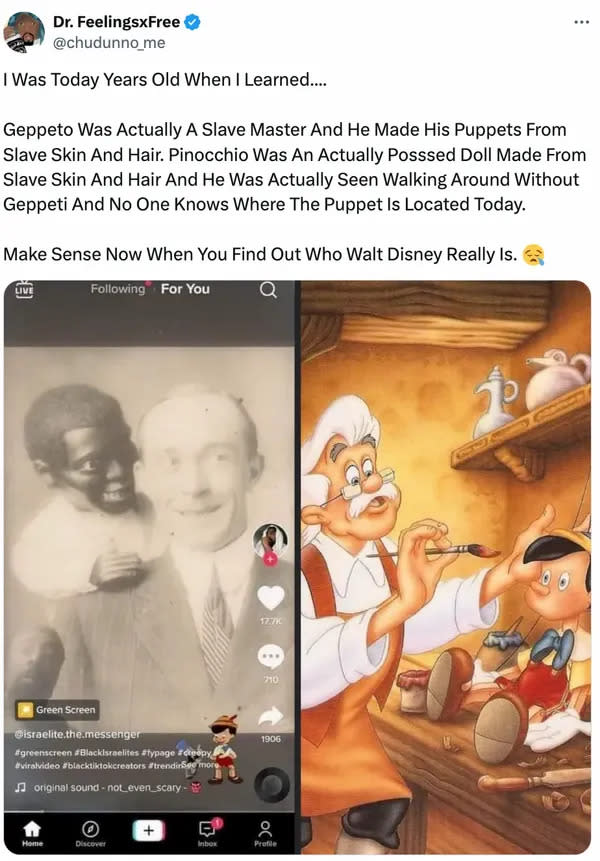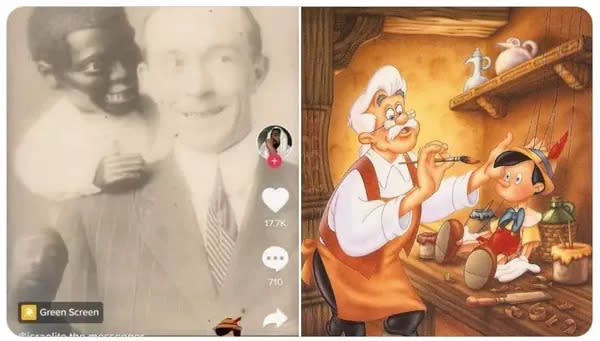Fact Check: About That Meme Claiming Geppetto Was a 'Slave Master' Who Built Pinocchio Out of Slaves' Skin and Hair

Claim:
Geppetto, the woodcarver in "The Adventures of Pinocchio" who created a walking, talking puppet out of wood, was actually a slave owner who built Pinocchio out of slaves' body parts.
Rating:
On May 14, 2024, a rumor went viral on X, claiming that the original Geppetto (misspelled in the posts) — the woodcarver in "The Adventures of Pinocchio" — was actually a "slave master," and the original Pinocchio — the walking, talking wooden puppet made by Geppetto in the story — was actually built out of the body parts of slaves.
"Make sense now when you find out who Walt Disney really is," the post said. (Most people are familiar with the "Pinocchio" story and characters via Disney's animated feature film of that name.) As of this writing, this post had reached more than 1.7 million views, 9,100 reactions, and 3,100 shares:

(X user @chudunno_me)
It read:
I Was Today Years Old When I Learned....
Geppeto Was Actually A Slave Master And He Made His Puppets From Slave Skin And Hair. Pinocchio Was An Actually Posssed [sic] Doll Made From Slave Skin And Hair And He Was Actually Seen Walking Around Without Geppeti And No One Knows Where The Puppet Is Located Today.
Make Sense Now When You Find Out Who Walt Disney Really Is. 😪
The claim also spread on other social media platforms, such as Instagram and Facebook.
We have rated this claim as "False" because there are no such story elements to be found in Carlo Collodi's book "The Adventures of Pinocchio."
Walt Disney's "Pinocchio" was released in 1940 and is one of the studio's most-beloved animated classics, adapted from Collodi's equally classic children's book, which first appeared in serial form in 1881 in the "Giornale dei bambini" ("Children's Magazine"), and was published as a book in 1883. It tells the story of a little marionette who wants to be a real boy, Encyclopedia Britannica explains:
Adapted from a novel by C. Collodi, it chronicles the adventures of a wooden puppet whose lonely maker, Geppetto, wishes were a real boy. A fairy grants his wish by bringing the puppet, Pinocchio, to life, but she tells Pinocchio that he must prove his worth before she will make him into a human boy. Under the guidance of his insect friend, Jiminy Cricket, Pinocchio experiences a series of incredible adventures on his way to becoming a real boy. He is deterred from deceit in his new life by his nose, which grows longer every time he tells a lie.
The National Carlo Collodi Foundation, a nonprofit organization dedicated to promoting a culture of and for children, reported:
Its first appearance in the United States was in 1898, with publication of the first US edition in 1901, translated and illustrated by Americans: Walter S. Cramp and Charles Copeland. From that time, well before the global success of Walt Disney's Pinocchio, the adventures of the puppet were one of the best loved children's books for many Americans and an important step for many illustrators.
The viral post was accompanied by this collage of two images:

(@honey_bee48 / X)
The image on the right is a modern illustration showing Geppetto and Pinocchio. However, the origins of the photograph on the left are unknown. It has circulated on the internet for years in various other contexts.
"Need MORE reason to hate ventriloquists? Here's your next nightmare. 1920s," a 2014 Reddit post captioned the image.

(Reddit u/ShadowNozeKnows)
TinEye reverse image search results indicated that the photograph has been shared online since at least 2009 and showed a ventriloquist dummy. The fact-checking website Lead Stories unearthed an instance of the photo being shared in 2008. In sum, there is no concrete evidence linking the photograph to any version of the Pinocchio story.
The "Geppetto was a slave master" claim might have been inspired by a quote from the 2022 animated film adaptation of the story "Guillermo del Toro's Pinocchio." At one point, according to IMDb, the villainous Count Volpe says to Pinocchio (emphasis added):
I think you misunderstand our relationship, my little fire hazard. I am the puppeteer, you are the puppet. I am the master, you are the slave! And you will do as I command, until your wooden body rots and I use you to warm my furnace! You may have no strings, but I control you. You obey ME! Capisce?
The fact-checking organization Check Your Fact debunked a similar claim in 2022, quoting a professor with expertise in European fairy tales:
"I have never heard such a thing," said Cristina Mazzoni, a professor at the University of Vermont with expertise in European fairy tales, in an email to Check Your Fact. "While it is true that in the original Italian book Geppetto made his puppet with the intention of exploiting him in street performances, Pinocchio was made entirely out of a single piece of wood. What an odd claim."
However, as some social media users noted, "The Adventures of Pinocchio" was once a "dark story," but for a different reason.
TIL the original 1881 "Pinocchio" was a dark story that included the puppet's execution by hanging for his bad behavior (which included murdering Jiminy Cricket)
by u/foodtower in todayilearned
Encyclopedia Britannica explains that the original version of the book ended with Pinocchio's hanging:
Collodi's original serial, which was titled Le avventure di Pinocchio: storia di un burattino ("The Adventures of Pinocchio: The Story of a Puppet"), was meant to serve as a warning against bad behaviour, and it ended with Pinocchio's fatal hanging. The disappointment of the story's fans, however, led Collodi's publishers to insist that he resurrect Pinocchio and continue the puppet's adventures.
Sources:
Fact Check: Original Pinocchio Story Does NOT Say Gepetto Was Slave Master Who Made Puppet From Human Skin, Hair | Lead Stories. 14 May 2024, https://leadstories.com/hoax-alert/2024/05/fact-check-original-pinocchio-story-does-not-say-gepetto-was-slave-master-who-made-puppet-from-human-skin-hair.html.
FACT CHECK: Viral Claim Linking Pinocchio To Slavery Is Unfounded. https://checkyourfact.com/2022/05/04/fact-check-pinocchio-slavery-viral-claim/. Accessed 15 May 2024.
Guillermo Del Toro's Pinocchio (2022) - Quotes - IMDb. www.imdb.com, https://www.imdb.com/title/tt1488589/quotes/. Accessed 15 May 2024.
hastingsgraham. Ventriloquist & Dummy. photo, 9 Oct. 2009. Flickr, https://www.flickr.com/photos/31472241@N03/3315078364/.
Hill, Mark. "13 Old-Timey Photos That Prove History Was Haunted." Cracked.Com, 30 Oct. 2012, https://www.cracked.com/article_20070_13-old-timey-photos-that-prove-history-was-haunted.html.
info@e-project.it, e-Project-. The Carlo Collodi National Foundation - Fondazione Collodi. https://www.fondazionecollodi.it/en/fondazione-carlo-collodi. Accessed 15 May 2024.
Pinocchio | Movie, Disney, Plot, Characters, & Facts | Britannica. 29 Mar. 2024, https://www.britannica.com/topic/Pinocchio-film-1940.
The Adventures of Pinocchio | Fondazione Pinocchio - Carlo Collodi. 9 Sept. 2019, https://web.archive.org/web/20190909163609/https://www.pinocchio.it/fondazionecollodi/en/the-adventures-of-pinocchio/.
The Adventures of Pinocchio | Summary, Characters, & Facts | Britannica. https://www.britannica.com/topic/The-Adventures-of-Pinocchio. Accessed 15 May 2024.
Things We Like: Ghost Flubs, Mutant Kangaroos and Vent Figs << Monkey Goggles. 8 Nov. 2009, https://web.archive.org/web/20091108130504/https://monkeygoggles.com/?p=1612.

 Yahoo News
Yahoo News 

